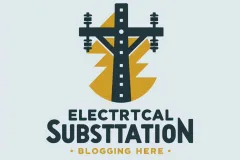What is Overcurrent Relay?
An overcurrent relay is a protective device used by electrical engineers to monitor current flow in power systems and automatically disconnect circuits when current levels exceed predetermined safe thresholds.This relay used as a backup in Transmission line protection.
What is Earth Fault Relay?
An earth fault relay protects against ground faults where current flows from live conductors to earth. This relay detects zero-sequence current and operates when insulation failure occurs, preventing fire hazards and equipment damage.

Overcurrent Relay Setting Calculation
1. Pickup Current Setting
Time Overcurrent relay using definite Characteristics
For example: CT Ratio: 800/1A
Rated Voltage: 132kV
For Phase element
Plug Setting:
Considering maximum current through the circuit: 800A
I am taking here 90% =0.9*In =0.9
Current Setting =720/800
Correspondence secondary current IN =0.9
Hence pick up setting =0.9A
2. Time Multiplier Setting (TMS) OR (TDS)
Formula: TMS = (Operating Time × (PSM^0.02 – 1)) ÷ 0.14
Where PSM = Plug Setting Multiplier = Fault Current ÷ Pickup Current
For coordination with downstream relay:
- For Numerical Relay TMS typically ranges from 0.1 to 1.0 (=0.5 sec)
- For Electro Mechanical Relay TDS Typically ranges from 0.1 to 1.0
- Higher TMS or TDS = longer operating time
So Plug Setting: =0.9A
TMS Setting: =0.5 sec
Instantaneous Setting: =Blocked
Earth Fault Relay Setting Calculation
1. Earth Fault Pickup Setting
Plug Setting:
Considering maximum current through the circuit: 800A
I am taking here 20% =0.2*In =0.2 =160A
Current Setting =160/800
Correspondence secondary current IN =0.2 A
Hence pick up setting =0.2A
2. Earth Fault Time Setting(TMS)
Operating time of back up protection at local substation =0.5sec
So, Plug Setting: =0.2A
TMS Setting: =0.5 sec
Characteristic =Definite time
Instantaneous Setting: =Blocked
Why Install Distance Relay When Using Overcurrent and Earth Fault Relays?
Question: If we already have overcurrent and earth fault relays on 132kV transmission lines, why do we need distance relays?
Answer: For radial line systems, overcurrent and earth fault relays work perfectly with proper coordination(time and current grading). However, in ring main systems or interconnected networks, overcurrent relays face limitations so that’s why we use Distance.
Limitations of Overcurrent Relays in Ring Systems:
1.Direction Problem: Current can flow in both directions, making coordination difficult
- Variable Fault Current: Fault current changes with system configuration
- Selectivity Issues: Cannot distinguish between faults on different line sections
- Load vs Fault: Heavy load current may approach fault current levels
- Backup Protection: Longer operating times affect system stability
Distance Relay Advantages:
- Impedance Based: Measures fault location regardless of current direction
- Fast Operation: Typically operates in 80-120 milliseconds
- Directional Protection: Can determine fault direction automatically
- Zone Protection: Provides stepped distance protection (Zone 1, 2, 3)
- Load Immunity: Not affected by load current variations
This is why modern 132kV substations use distance relays as primary protection and overcurrent relays as backup protection by using definite time characteristic for comprehensive line protection.
Key Considerations for Grid Station Technicians
- Coordination: Ensure proper time and current grading with adjacent relays
- Sensitivity: Settings must detect minimum fault current
- Stability: Avoid unwanted tripping during normal switching
- CT Accuracy: Consider CT saturation limits
- System Studies: Use load flow and fault analysis data
Conclusion
Proper overcurrent and earth fault relay settings ensure reliable 132kV transmission line protection. Regular testing and coordination studies (time and current grading) help maintain grid stability and prevent cascading failures in power systems.



